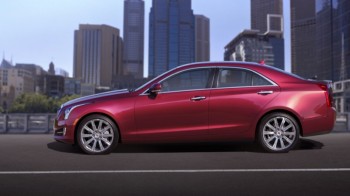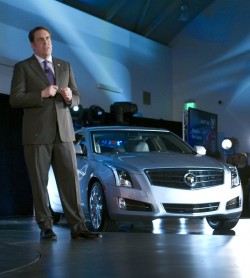ATS Weight Savings - The Story of an Unexpected Development
Image Gallery of the new ATS As much as the ATS was anticipated for years now, we have been filling the vacuum with rumors and speculation.
During this time, a couple key 'facts' have filled the void - 1. CEO of GM saying that the ATS would be 'competitive' - which was taken as code for 'we aren't quite happy with the car and don't expect it to really be a 3-series competitor' and 2. The ATS is way overweight and the engineers are scrambling to cut some of the pork to get the mass down to a less embarrassing level.
In fact, we were hearing all sorts of supporting rumors that the ATS program was a complete disaster with Cadillac making last minute demands of the Alpha development team that it needed to be able to house a 6 (the story was that Alpha was originally 4-cylinder only). Then after that shakeup and its related bloat of the chassis...Cadillac required it be able to accommodate AWD and that forced a change of front suspension geometry - more mass yet again and a compromise to handling and steering feel.
It remains to be seen how the ATS will drive, but it appears that the mass problems might have been overblown.
In the ATS, if the reports from Cadillac are to be believed, mass was always the enemy and the ultimate result is a highly engineered car that is ultimately among if not the lowest weight car in its class (final numbers will come closer to production, but currently it is, at worst, a mere 38 lbs more than the BMW 3-series and actually lighter than all other competitors).
As much as the ATS was anticipated for years now, we have been filling the vacuum with rumors and speculation.
During this time, a couple key 'facts' have filled the void - 1. CEO of GM saying that the ATS would be 'competitive' - which was taken as code for 'we aren't quite happy with the car and don't expect it to really be a 3-series competitor' and 2. The ATS is way overweight and the engineers are scrambling to cut some of the pork to get the mass down to a less embarrassing level.
In fact, we were hearing all sorts of supporting rumors that the ATS program was a complete disaster with Cadillac making last minute demands of the Alpha development team that it needed to be able to house a 6 (the story was that Alpha was originally 4-cylinder only). Then after that shakeup and its related bloat of the chassis...Cadillac required it be able to accommodate AWD and that forced a change of front suspension geometry - more mass yet again and a compromise to handling and steering feel.
It remains to be seen how the ATS will drive, but it appears that the mass problems might have been overblown.
In the ATS, if the reports from Cadillac are to be believed, mass was always the enemy and the ultimate result is a highly engineered car that is ultimately among if not the lowest weight car in its class (final numbers will come closer to production, but currently it is, at worst, a mere 38 lbs more than the BMW 3-series and actually lighter than all other competitors).
 Personally, it is uncommon to hear of an engineering team fighting for grams of weight and looking closely at each and every part of the car. The only manufacturer I have seen that had that level of obsession was Mazda and it was when building cars like the Miata and the RX sports cars - in their case they had a similar story to tell about how they shaved grams from parts like a rear-view mirror. The ultimate result of such obsession is that the grams start to add up to real savings measured in many pounds.
These are changes and savings that could still be made in the run-up to production. Likely this is why we don't know for sure what the final curb weight of the ATS will be (and why I wouldn't be surprised if the ATS beats the 3-series curb weight to become the lightest car in its class before the ATS goes on sale in the summer).
If this 'sure thing' rumor has been this wrong - I can't wait to get some seat time to see exactly how wrong the 'steering and front suspension geometry have been compromised' rumor-mongers have been as well.
I'm more excited than ever about the prospects of the ATS as a potential 3-series beater.
See the press release about the mass reduction focus below:DETROIT – From the very outset of development, engineers focused on making the Cadillac ATS one of the lightest cars in the compact luxury segment. Its curb weight of less than 3,400 pounds (1,542 kg) is a key contributor to a world-class driving experience and helps make the new sport sedan more efficient.
An aluminum hood, magnesium engine mount brackets and even lightweight, natural-fiber door trim panels contribute to the ATS’s low overall mass – and reflect the systematic approach of evaluating every ounce that goes into the car.
“Low weight helps enable the ATS’s driving experience, making it feel more nimble and controllable,” said Dave Masch, ATS chief engineer. “Mass efficiency helps the car respond more immediately and precisely to driver input, and improves fuel efficiency.”
Discipline to mass efficiency was a driving force in the development of the ATS. The engineers and designers stayed true to the performance goals and desired driving character. The development team’s culture was also instrumental, as everyone from engineers to suppliers and leadership kept mass as a primary consideration.
“We thought about grams, not pounds, and looked at how even the smallest of changes could contribute to the overall mass goal,” said Masch.
Load and space management – what engineers and mathematicians call topology – was applied during the design of the car’s structure. That helped ensure mass efficiency was built into the very foundation of this all-new architecture. Advanced computational development helped determine the most efficient design, emphasizing strength and stiffness via the use of high-tech materials. High-strength steel (HSS) and ultra-high-strength steel (UHSS) are used most effectively to reduce mass and optimize crash protection.
The ATS features UHSS in areas such as cross-vehicle beams around the “safety cage” of the body structure.
Compared to conventional steel used in most body structures, the yield and tensile strength of HSS is about four times better, while UHSS – which can include boron steel – is up to four times stronger than high-strength steel. That allows these strategic parts to be made of thinner gauges for reduced weight, while still offering the same – or greater – strength of bulkier structures made of conventional steel.
ATS powertrain and suspension systems feature extensive use of aluminum, another material that offers an excellent blend of strength and low mass. Many of the links for the front suspension are aluminum, as well as the front suspension cradle on both rear-wheel-drive and all-wheel-drive models. Also, the design of each component was carefully studied to optimize size and form.
“The design of each part was refined carefully, so excess material that didn’t contribute to function or strength was eliminated,” said Masch.
The aluminum-intensive powertrains not only helped minimize overall weight, they are instrumental in favorable power-to-weight ratios that contribute to the ATS’s willing feeling of performance. With the 3.6L V-6, for example:
Personally, it is uncommon to hear of an engineering team fighting for grams of weight and looking closely at each and every part of the car. The only manufacturer I have seen that had that level of obsession was Mazda and it was when building cars like the Miata and the RX sports cars - in their case they had a similar story to tell about how they shaved grams from parts like a rear-view mirror. The ultimate result of such obsession is that the grams start to add up to real savings measured in many pounds.
These are changes and savings that could still be made in the run-up to production. Likely this is why we don't know for sure what the final curb weight of the ATS will be (and why I wouldn't be surprised if the ATS beats the 3-series curb weight to become the lightest car in its class before the ATS goes on sale in the summer).
If this 'sure thing' rumor has been this wrong - I can't wait to get some seat time to see exactly how wrong the 'steering and front suspension geometry have been compromised' rumor-mongers have been as well.
I'm more excited than ever about the prospects of the ATS as a potential 3-series beater.
See the press release about the mass reduction focus below:DETROIT – From the very outset of development, engineers focused on making the Cadillac ATS one of the lightest cars in the compact luxury segment. Its curb weight of less than 3,400 pounds (1,542 kg) is a key contributor to a world-class driving experience and helps make the new sport sedan more efficient.
An aluminum hood, magnesium engine mount brackets and even lightweight, natural-fiber door trim panels contribute to the ATS’s low overall mass – and reflect the systematic approach of evaluating every ounce that goes into the car.
“Low weight helps enable the ATS’s driving experience, making it feel more nimble and controllable,” said Dave Masch, ATS chief engineer. “Mass efficiency helps the car respond more immediately and precisely to driver input, and improves fuel efficiency.”
Discipline to mass efficiency was a driving force in the development of the ATS. The engineers and designers stayed true to the performance goals and desired driving character. The development team’s culture was also instrumental, as everyone from engineers to suppliers and leadership kept mass as a primary consideration.
“We thought about grams, not pounds, and looked at how even the smallest of changes could contribute to the overall mass goal,” said Masch.
Load and space management – what engineers and mathematicians call topology – was applied during the design of the car’s structure. That helped ensure mass efficiency was built into the very foundation of this all-new architecture. Advanced computational development helped determine the most efficient design, emphasizing strength and stiffness via the use of high-tech materials. High-strength steel (HSS) and ultra-high-strength steel (UHSS) are used most effectively to reduce mass and optimize crash protection.
The ATS features UHSS in areas such as cross-vehicle beams around the “safety cage” of the body structure.
Compared to conventional steel used in most body structures, the yield and tensile strength of HSS is about four times better, while UHSS – which can include boron steel – is up to four times stronger than high-strength steel. That allows these strategic parts to be made of thinner gauges for reduced weight, while still offering the same – or greater – strength of bulkier structures made of conventional steel.
ATS powertrain and suspension systems feature extensive use of aluminum, another material that offers an excellent blend of strength and low mass. Many of the links for the front suspension are aluminum, as well as the front suspension cradle on both rear-wheel-drive and all-wheel-drive models. Also, the design of each component was carefully studied to optimize size and form.
“The design of each part was refined carefully, so excess material that didn’t contribute to function or strength was eliminated,” said Masch.
The aluminum-intensive powertrains not only helped minimize overall weight, they are instrumental in favorable power-to-weight ratios that contribute to the ATS’s willing feeling of performance. With the 3.6L V-6, for example:
- The cylinder block and cylinder heads are cast in aluminum.
- A composite intake manifold saves approximately 5.5 pounds (2.5 kg) over the weight of a comparable aluminum intake.
- An integrated cylinder head/exhaust manifold design saves approximately 13 pounds (6 kg) per engine when compared with a comparable engine with separate head/manifold assemblies.
- The connecting rods are made of powdered metal with a higher ratio of copper, which makes them stronger and helped reduce weight.
- The pistons are made of lightweight cast aluminum, which means less reciprocating mass in the engine for less inertia and greater operating efficiency.
But for all their gram-shaving initiatives, engineers were careful to balance the ATS’s mass to ensure Cadillac’s signature refinement wasn’t sacrificed. Thinner door glass, for example, would have saved a few pounds, but at the expense of increased road noise. Weight was even put back into aluminum wheel castings during the development process to enhance strength and reduce road noise. The 2013 Cadillac ATS goes on sale during the second half of 2012.
